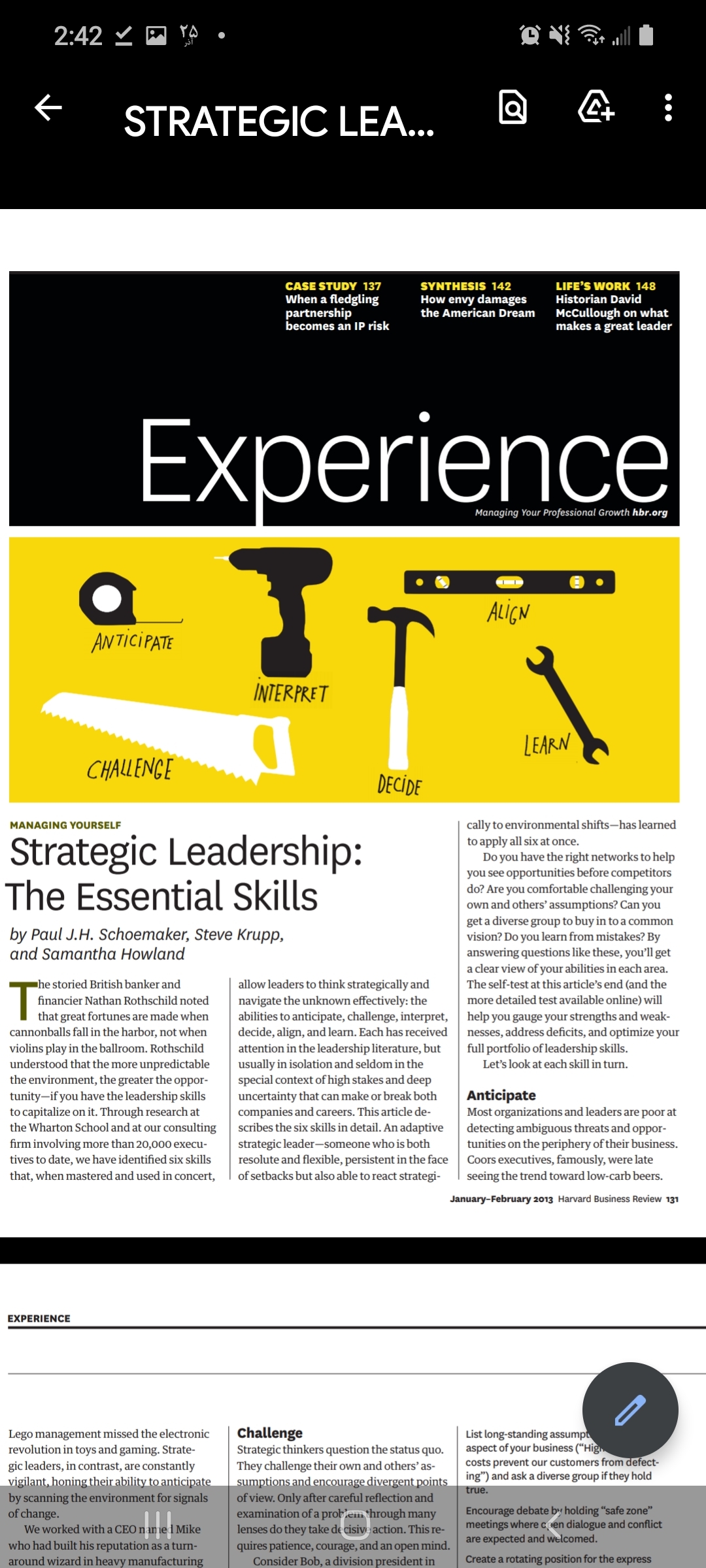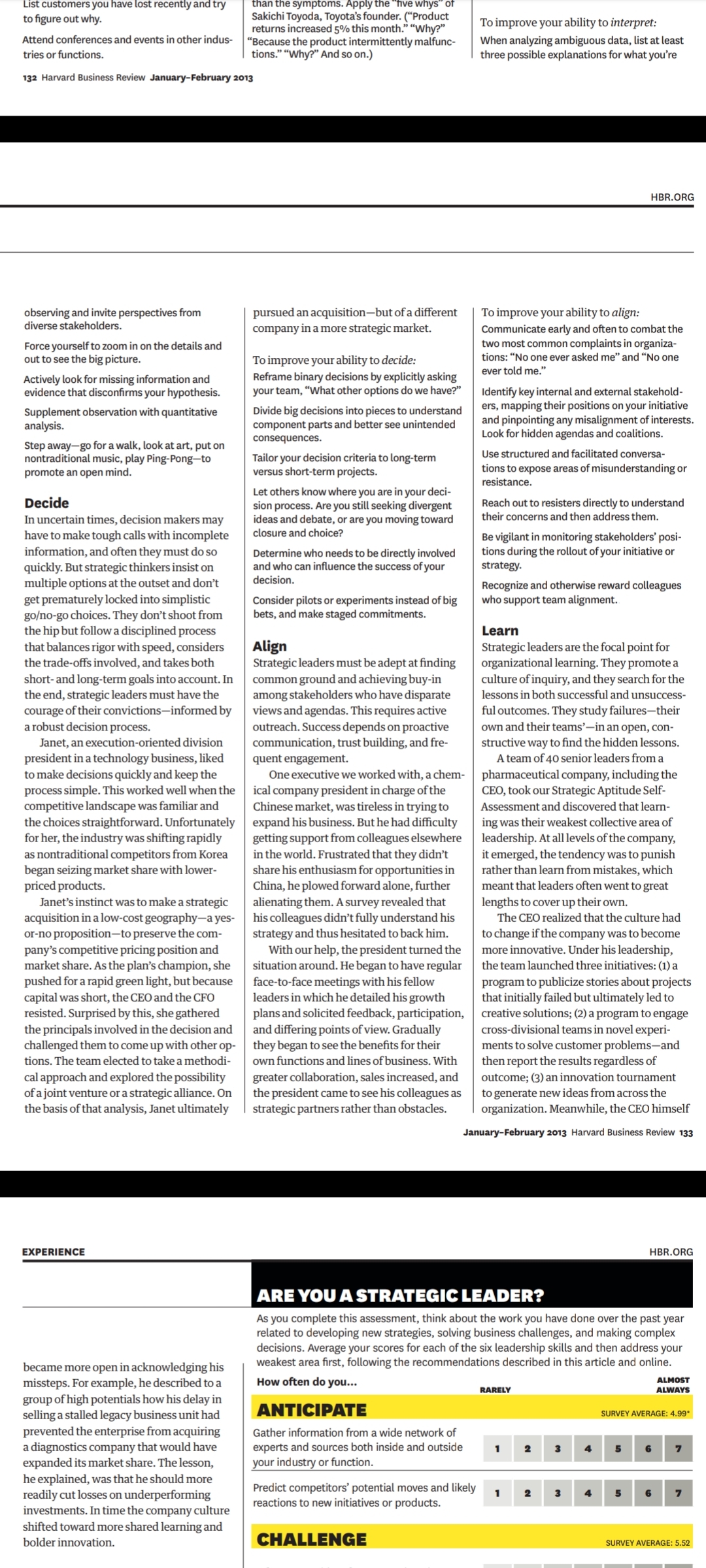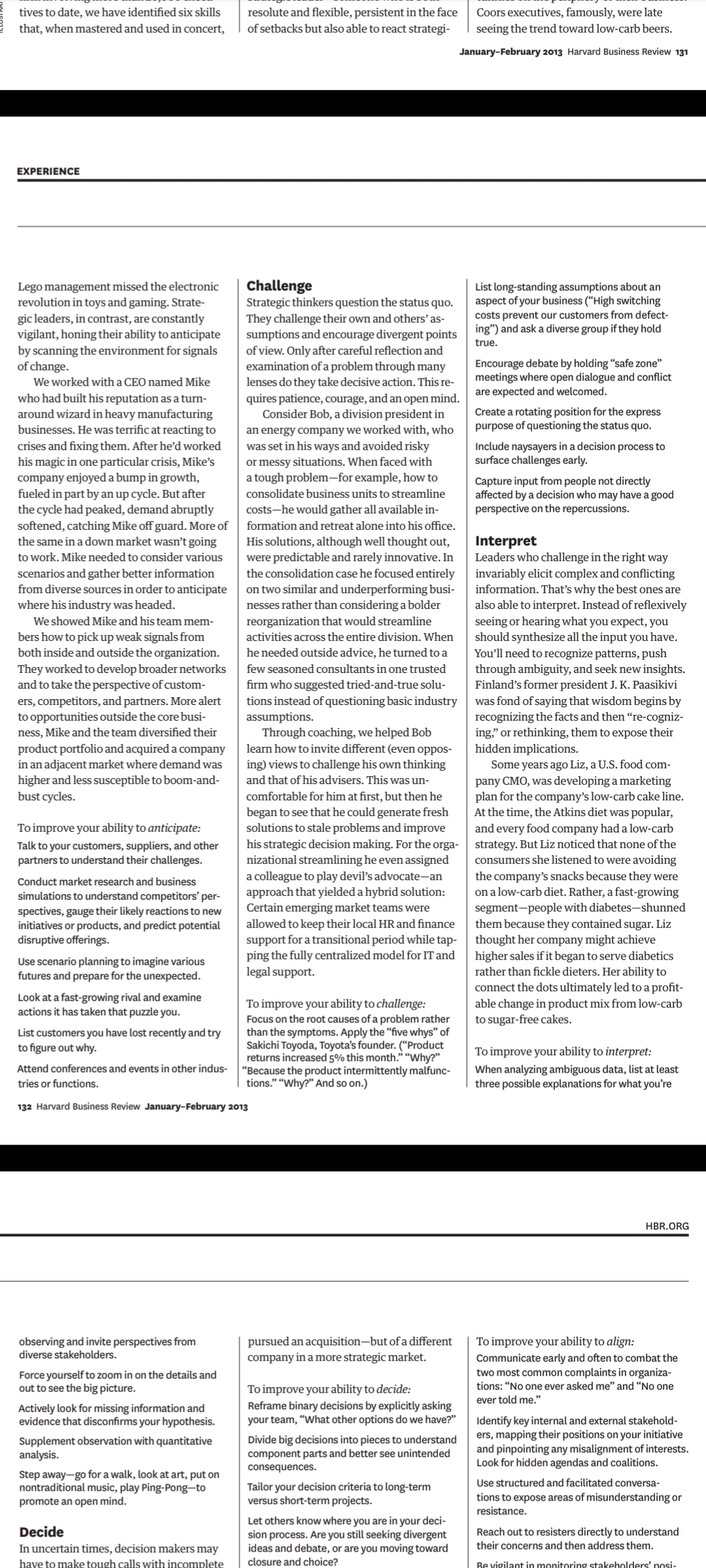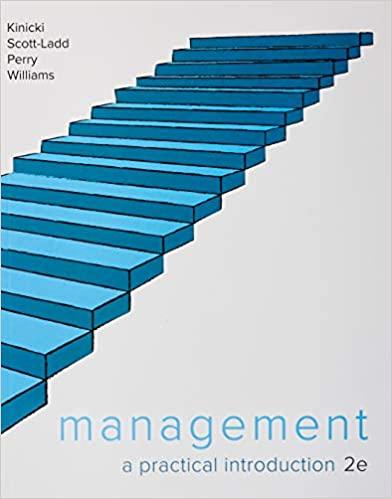Hi could you please read the article on Strategic Leadership by Schoemaker,P at al (2013) and help me answer the question?After reading the article "Case Study 137 When a fledgling partnership becomes an IP risk" select anythreeof the six skills discussed by the authors for your written submission.You must make clear and direct reference to specific concepts from our Hughes et.al. 2019 enhancingthe lesson of experience, as they relate to your three selections of the six skills from the article
2:42 V P YO STRATEGIC LEA... 4 . . CASE STUDY 137 SYNTHESIS 142 LIFE'S WORK 148 When a fledgling How envy damages Historian David partnership the American Dream Mccullough on what becomes an IP risk makes a great leader Experience Managing Your Professional Growth hbr.org a . Q D . ALIGN ANTICIPATE INTERPRET LEARN CHALLENGE DECIDE MANAGING YOURSELF cally to environmental shifts-has learned Strategic Leadership: to apply all six at once. Do you have the right networks to help you see opportunities before competitors The Essential Skills do? Are you comfortable challenging your own and others' assumptions? Can you get a diverse group to buy in to a common by Paul J.H. Schoemaker, Steve Krupp, vision? Do you learn from mistakes? By and Samantha Howland answering questions like these, you'll get a clear view of your abilities in each area. he storied British banker and allow leaders to think strategically and The self-test at this article's end (and the inancier Nathan Rothschild noted navigate the unknown effectively: the more detailed test available online) will hat great fortunes are made when abilities to anticipate, challenge, interpret, help you gauge your strengths and weak- cannonballs fall in the harbor, not when decide, align, and learn. Each has received nesses, address deficits, and optimize your violins play in the ballroom. Rothschild attention in the leadership literature, but full portfolio of leadership skills. understood that the more unpredictable usually in isolation and seldom in the Let's look at each skill in turn. the environment, the greater the oppor- special context of high stakes and deep tunity-if you have the leadership skills uncertainty that can make or break both Anticipate to capitalize on it. Through research at companies and careers. This article de- Most organizations and leaders are poor at the Wharton School and at our consulting scribes the six skills in detail. An adaptive detecting ambiguous threats and oppor- firm involving more than 20,000 execu- strategic leader-someone who is both tunities on the periphery of their business. tives to date, we have identified six skills resolute and flexible, persistent in the face Coors executives, famously, were late that, when mastered and used in concert, of setbacks but also able to react strategi- seeing the trend toward low-carb beers. January-February 2013 Harvard Business Review 131 EXPERIENCE Lego management missed the electronic Challenge List long-standing assumpt revolution in toys and gaming. Strate- Strategic thinkers question the status quo. aspect of your business ("High gic leaders, in contrast, are constantly They challenge their own and others' as- costs prevent our customers from defect- vigilant, honing their ability to anticipate sumptions and encourage divergent points ing") and ask a diverse group if they hold true. by scanning the environment for signals of view. Only after careful reflection and of change. examination of a problem through many Encourage debate by holding "safe zone" We worked with a CEO named Mike lenses do they take decisive action. This re- meetings where coen dialogue and conflict who had built his reputation as a turn- quires patience, courage, and an open mind. are expected and welcomed around wizard in heavy manufacturing Consider Bob, a division president in Create a rotating position for the expressList customers you have lost recently and try than the symptoms. Apply the " five whys" of to figure out why. Sakichi Toyoda, Toyota's founder. ("Product returns increased 5% this month." "Why?" To improve your ability to interpret: Attend conferences and events in other indus- 'Because the product intermittently malfunc When analyzing ambiguous data, list at least tries or functions. tions." "Why?" And so on. three possible explanations for what you're 132 Harvard Business Review January-February 2013 HBR.ORG observing and invite perspectives from pursued an acquisition-but of a different To improve your ability to align: diverse stakeholders. company in a more strategic market. Communicate early and often to combat the Force yourself to zoom in on the details and two most common complaints in organiza- out to see the big picture. To improve your ability to decide: tions: "No one ever asked me" and "No one Reframe binary decisions by explicitly asking ever told me." Actively look for missing information and evidence that disconfirms your hypothesis. your team, "What other options do we have?" identify key internal and external stakehold- Supplement observation with quantitative Divide big decisions into pieces to understand ers, mapping their positions on your initiative analysis. component parts and better see unintended and pinpointing any misalignment of interests. Step away-go for a walk, look at art, put on consequences. Look for hidden agendas and coalitions. nontraditional music, play Ping-Pong-to Tailor your decision criteria to long-term Use structured and facilitated conversa- promote an open mind. versus short-term projects. tions to expose areas of misunderstanding or resistance. Let others know where you are in your deci- Decide sion process. Are you still seeking divergent Reach out to resisters directly to understand In uncertain times, decision makers may ideas and debate, or are you moving toward their concerns and then address them. have to make tough calls with incomplete closure and choice? Be vigilant in monitoring stakeholders' posi- information, and often they must do so Determine who needs to be directly involved tions during the rollout of your initiative or quickly. But strategic thinkers insist on and who can influence the success of your strategy. multiple options at the outset and don't decision. Recognize and otherwise reward colleagues get prematurely locked into simplistic Consider pilots or experiments instead of big who support team alignment. goo-go choices. They don't shoot from bets, and make staged commitments. the hip but follow a disciplined process Learn that balances rigor with speed, considers Align Strategic leaders are the focal point for the trade-offs involved, and takes both Strategic leaders must be adept at finding organizational learning. They promote a short- and long-term goals into account. In common ground and achieving buy-in culture of inquiry, and they search for the the end, strategic leaders must have the among stakeholders who have disparate lessons in both successful and unsuccess- courage of their convictions-informed by views and agendas. This requires active ful outcomes. They study failures-their a robust decision process. outreach. Success depends on proactive own and their teams'-in an open, con- Janet, an execution-oriented division communication, trust building, and fre- structive way to find the hidden lessons. president in a technology business, liked quent engagement. A team of 40 senior leaders from a to make decisions quickly and keep the One executive we worked with, a chem- pharmaceutical company, including the process simple. This worked well when the ical company president in charge of the CEO, took our Strategic Aptitude Self- competitive landscape was familiar and Chinese market, was tireless in trying to Assessment and discovered that learn- the choices straightforward. Unfortunately expand his business. But he had difficulty ing was their weakest collective area of for her, the industry was shifting rapidly getting support from colleagues elsewhere leadership. At all levels of the company, as nontraditional competitors from Korea in the world. Frustrated that they didn't it emerged, the tendency was to punish began seizing market share with lower- share his enthusiasm for opportunities in rather than learn from mistakes, which priced products. China, he plowed forward alone, further meant that leaders often went to great Janet's instinct was to make a strategic alienating them. A survey revealed that lengths to cover up their own. acquisition in a low-cost geography-a yes- his colleagues didn't fully understand his The CEO realized that the culture had or-no proposition-to preserve the com- strategy and thus hesitated to back him. to change if the company was to become pany's competitive pricing position and With our help, the president turned the more innovative. Under his leadership, market share. As the plan's champion, she situation around. He began to have regular the team launched three initiatives: (1) a pushed for a rapid green light, but because face-to-face meetings with his fellow program to publicize stories about projects capital was short, the CEO and the CFO leaders in which he detailed his growth that initially failed but ultimately led to resisted. Surprised by this, she gathered plans and solicited feedback, participation, creative solutions; (2) a program to engage the principals involved in the decision and and differing points of view. Gradually cross-divisional teams in novel experi- challenged them to come up with other op- they began to see the benefits for their ments to solve customer problems-and tions. The team elected to take a methodi- own functions and lines of business. With then report the results regardless of cal approach and explored the possibility greater collaboration, sales increased, and outcome; (3) an innovation tournament of a joint venture or a strategic alliance. On the president came to see his colleagues as to generate new ideas from across the the basis of that analysis, Janet ultimately strategic partners rather than obstacles. organization. Meanwhile, the CEO himself January-February 2013 Harvard Business Review 133 EXPERIENCE HBR.ORG ARE YOU A STRATEGIC LEADER? As you complete this assessment, think about the work you have done over the past year related to developing new strategies, solving business challenges, and making complex decisions. Average your scores for each of the six leadership skills and then address your became more open in acknowledging his weakest area first, following the recommendations described in this article and online. missteps. For example, he described to a How often do you... ALMOST RARELY ALWAYS group of high potentials how his delay in selling a stalled legacy business unit had ANTICIPATE SURVEY AVERAGE: 4.99' prevented the enterprise from acquiring Gather information from a wide network of a diagnostics company that would have experts and sources both inside and outside expanded its market share. The lesson, your industry or function. he explained, was that he should more readily cut losses on underperforming Predict competitors' potential moves and likely 1 investments. In time the company culture reactions to new initiatives or products. shifted toward more shared learning and bolder innovation. CHALLENGE SURVEY AVERAGE: 5.52tives to date, we have identified six skills resolute and flexible, persistent in the face Coors executives, famously, were late that, when mastered and used in concert, of setbacks but also able to react strategi- seeing the trend toward low-carb beers. January-February 2013 Harvard Business Review 131 EXPERIENCE Lego management missed the electronic Challenge List long-standing assumptions about an revolution in toys and gaming. Strate- Strategic thinkers question the status quo. aspect of your business ("High switching gic leaders, in contrast, are constantly They challenge their own and others' as- costs prevent our customers from defect- vigilant, honing their ability to anticipate sumptions and encourage divergent points ing") and ask a diverse group if they hold by scanning the environment for signals of view. Only after careful reflection and true. of change. examination of a problem through many Encourage debate by holding "safe zone" We worked with a CEO named Mike lenses do they take decisive action. This re- meetings where open dialogue and conflict who had built his reputation as a turn- quires patience, courage, and an open mind. are expected and welcomed. around wizard in heavy manufacturing Consider Bob, a division president in Create a rotating position for the express businesses. He was terrific at reacting to an energy company we worked with, who purpose of questioning the status quo. crises and fixing them. After he'd worked was set in his ways and avoided risky Include naysayers in a decision process to his magic in one particular crisis, Mike's or messy situations. When faced with surface challenges early. company enjoyed a bump in growth, a tough problem-for example, how to Capture input from people not directly fueled in part by an up cycle. But after consolidate business units to streamline affected by a decision who may have a good the cycle had peaked, demand abruptly costs-he would gather all available in- perspective on the repercussions. softened, catching Mike off guard. More of formation and retreat alone into his office. the same in a down market wasn't going His solutions, although well thought out, Interpret to work. Mike needed to consider various were predictable and rarely innovative. In Leaders who challenge in the right way scenarios and gather better information the consolidation case he focused entirely invariably elicit complex and conflicting from diverse sources in order to anticipate on two similar and underperforming busi- information. That's why the best ones are where his industry was headed. nesses rather than considering a bolder also able to interpret. Instead of reflexively We showed Mike and his team mem- reorganization that would streamline seeing or hearing what you expect, you bers how to pick up weak signals from activities across the entire division. When should synthesize all the input you have. both inside and outside the organization. he needed outside advice, he turned to a You'll need to recognize patterns, push They worked to develop broader networks few seasoned consultants in one trusted through ambiguity, and seek new insights. and to take the perspective of custom- firm who suggested tried-and-true solu- Finland's former president J. K. Paasikivi ers, competitors, and partners. More alert tions instead of questioning basic industry was fond of saying that wisdom begins by to opportunities outside the core busi- assumptions. recognizing the facts and then "re-cogniz- ness, Mike and the team diversified their Through coaching, we helped Bob ing," or rethinking, them to expose their product portfolio and acquired a company learn how to invite different (even oppos- hidden implications. in an adjacent market where demand was ing) views to challenge his own thinking Some years ago Liz, a U.S. food com- higher and less susceptible to boom-and- and that of his advisers. This was un- pany CMO, was developing a marketing bust cycles. comfortable for him at first, but then he plan for the company's low-carb cake line. began to see that he could generate fresh At the time, the Atkins diet was popular, To improve your ability to anticipate: solutions to stale problems and improve and every food company had a low-carb Talk to your customers, suppliers, and other his strategic decision making. For the orga- strategy. But Liz noticed that none of the partners to understand their challenges. nizational streamlining he even assigned consumers she listened to were avoiding Conduct market research and business a colleague to play devil's advocate-an the company's snacks because they were simulations to understand competitors' per- approach that yielded a hybrid solution: on a low-carb diet. Rather, a fast-growing spectives, gauge their likely reactions to new Certain emerging market teams were segment-people with diabetes-shunned nitiatives or products, and predict potential allowed to keep their local HR and finance them because they contained sugar. Liz disruptive offerings support for a transitional period while tap- thought her company might achieve Use scenario planning to imagine various ping the fully centralized model for IT and higher sales if it began to serve diabetics futures and prepare for the unexpected. legal support. rather than fickle dieters. Her ability to connect the dots ultimately led to a profit- Look at a fast-growing rival and examine To improve your ability to challenge: able change in product mix from low-carb actions it has taken that puzzle you. Focus on the root causes of a problem rather to sugar-free cakes. List customers you have lost recently and try than the symptoms. Apply the "five whys" of to figure out why. Sakichi Toyoda, Toyota's founder. ("Product returns increased 5% this month." "Why?" To improve your ability to interpret: Attend conferences and events in other indus- Because the product intermittently malfunc When analyzing ambiguous data, list at least tries or functions tions." "Why?" And so on.) three possible explanations for what you're 132 Harvard Business Review January-February 2013 HBR.ORG observing and invite perspectives from pursued an acquisition-but of a different To improve your ability to align: diverse stakeholders. company in a more strategic market. Communicate early and often to combat the Force yourself to zoom in on the details and two most common complaints in organiza- out to see the big picture. To improve your ability to decide: tions: "No one ever asked me" and "No one Actively look for missing information and Reframe binary decisions by explicitly asking ever told me." evidence that disconfirms your hypothesis. your team, "What other options do we have?" Identify key internal and external stakehold- Supplement observation with quantitative Divide big decisions into pieces to understand ers, mapping their positions on your initiative analysis. component parts and better see unintended and pinpointing any misalignment of interests. Step away-go for a walk, look at art, put on consequences. Look for hidden agendas and coalitions. nontraditional music, play Ping-Pong-to Tailor your decision criteria to long-term Use structured and facilitated conversa- promote an open mind. versus short-term projects. tions to expose areas of misunderstanding or resistance. Let others know where you are in your deci- Decide sion process. Are you still seeking divergent Reach out to resisters directly to understand In uncertain times, decision makers may ideas and debate, or are you moving toward their concerns and then address them. closure and choice









